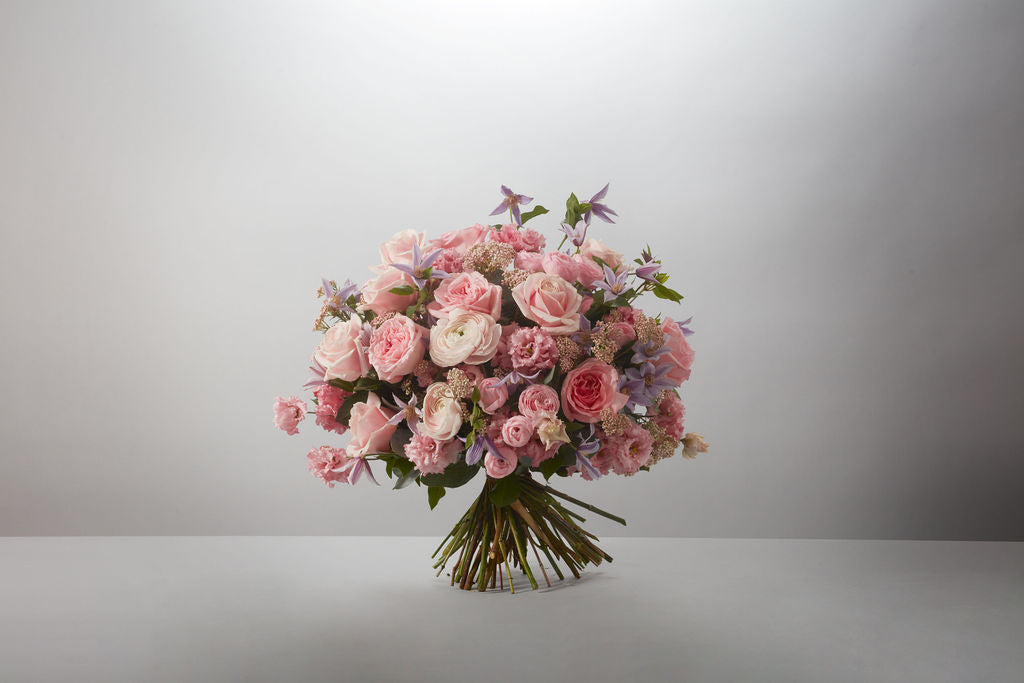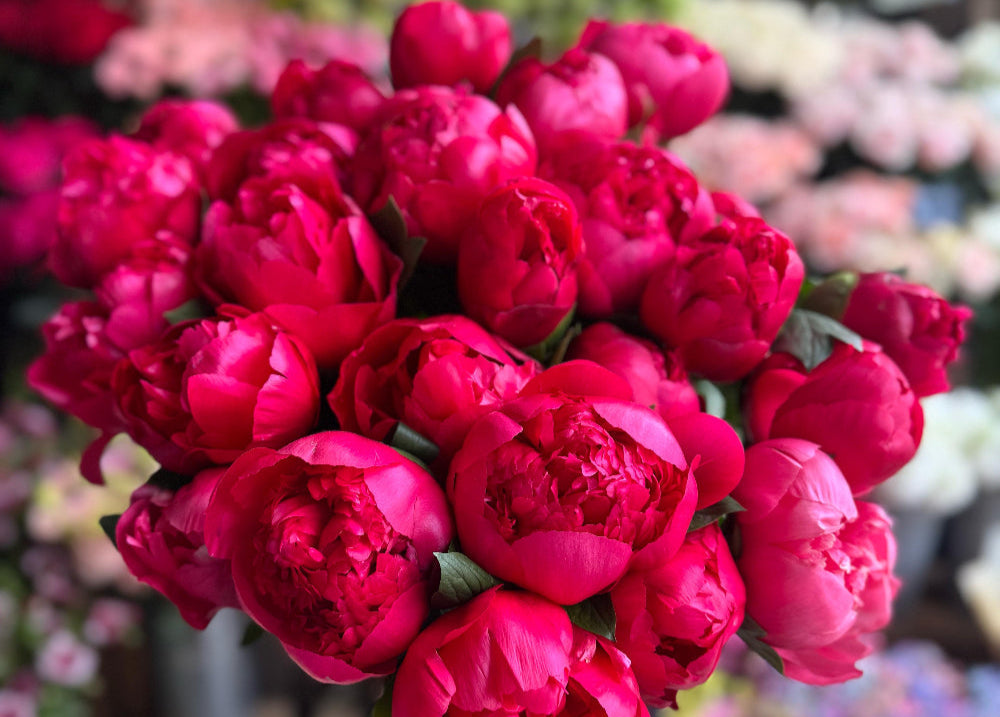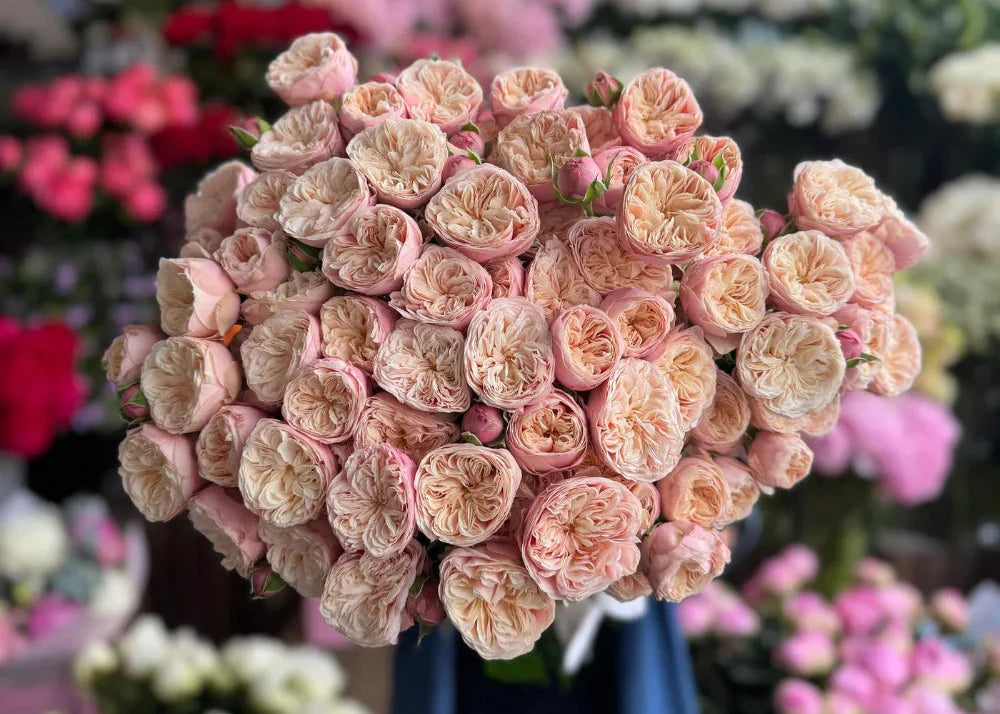The Art of Flower Conditioning: Professional Techniques for Extending Bloom Life
Discover the secrets professional florists use to dramatically extend the life of cut flowers. Learn step-by-step conditioning methods that transform ordinary care into extraordinary results for your luxury blooms.
The difference between flowers that fade within days and those that remain vibrant for weeks often lies not in the blooms themselves, but in how they are conditioned from the moment they are cut. At Petals at Bibendum, our luxury arrangements maintain their beauty far longer than typical bouquets because we employ professional conditioning techniques developed through years of floral expertise. This comprehensive guide reveals the professional methods that distinguish exceptional floristry from the ordinary, allowing you to achieve remarkable longevity from your premium blooms. From the science behind flower hydration to specialised techniques for different varieties, these professional insights will transform how you care for and enjoy cut flowers in your home.

Understanding the Science of Flower Longevity
The Critical First Hours: Why Initial Conditioning Matters
The moment a flower stem is cut, a complex chain of physiological responses begins that will ultimately determine its vase life:
Vascular System Disruption: Cutting triggers the flower's natural defense mechanisms, which can block water uptake if not properly managed. Professional conditioning prevents these blockages from forming.
Air Embolism Formation: Air can enter the stem's vascular system during cutting and transport, creating blockages that prevent proper hydration. Professional techniques eliminate these emboli before they can damage the bloom.
Bacterial Proliferation: Cut stems provide an ideal environment for bacterial growth, which can quickly clog stems and release toxins harmful to flowers. Proper conditioning creates an environment hostile to bacterial development.
The Physiology of Cut Flowers: What Happens Inside the Stem
Understanding the internal processes of cut flowers helps explain why professional conditioning techniques are so effective:
Transpiration Balance: Cut flowers continue to lose water through their petals and leaves while having limited ability to replace it. Professional conditioning creates the optimal balance between water uptake and transpiration.
Ethylene Sensitivity: Flowers produce and respond to ethylene gas, which accelerates aging. Certain conditioning techniques inhibit ethylene production and minimise its effects.
Carbohydrate Reserves: Cut flowers rely on stored carbohydrates for energy. Professional conditioning solutions provide supplemental carbohydrates that extend bloom life significantly.
Professional Conditioning Tools and Solutions
The Florist's Toolkit: Essential Equipment for Proper Conditioning
Professional florists rely on specialised tools that significantly impact flower longevity:
Floral Secateurs vs. Household Scissors: Professional-grade floral secateurs make clean cuts that maximise water uptake, while household scissors crush vascular tissues and reduce hydration efficiency by up to 40%.
Conditioning Buckets: Food-grade plastic buckets in specific depths allow for optimal stem submersion without damaging blooms. Professional florists use different bucket depths for different flower types.
Water Quality Testing Tools: Professional florists regularly test water pH and mineral content, as these factors significantly impact flower hydration and longevity.
Temperature Control Equipment: Specialised coolers maintain the ideal temperature for different varieties during the conditioning process, dramatically extending potential vase life.

Beyond Flower Food: Professional Hydration Solutions
Professional florists use specialised solutions at different stages of conditioning:
Initial Hydrators: These specialised solutions lower water's surface tension and remove air bubbles from stems, maximising water uptake during the critical first hour.
Professional Flower Foods: Unlike retail packet flower foods, professional solutions contain precisely balanced ratios of carbohydrates, acidifiers, and biocides tailored to specific flower types.
Ethylene Inhibitors: Professional-grade solutions that block ethylene production and reception, particularly important for sensitive varieties like carnations, lilies, and delphiniums.
Finishing Solutions: Clear solutions used after initial conditioning that maintain optimal stem health without leaving residue in the vase water.
The Professional Conditioning Process
Stage One: Initial Processing and Hydration
The first stage of professional conditioning establishes the foundation for maximum longevity:
Receiving Assessment: Professional florists immediately evaluate flowers upon arrival, identifying varieties requiring specialised treatment and prioritising processing order based on sensitivity.
Preparatory Cutting: Initial stem cuts are made underwater to prevent air from entering the vascular system, using sharp floral shears at precise 45-degree angles to maximise surface area for water uptake.
Foliage Management: Lower foliage is removed not just below the waterline but strategically throughout the stem to balance water distribution between leaves and blooms.
Initial Hydration: Flowers are placed in specialised hydration solutions at specific depths and temperatures based on variety, with certain flowers requiring full-stem submersion while others need minimal water contact.
Stage Two: Specialised Conditioning Techniques
After initial processing, professional florists apply variety-specific techniques:
Boiling Water Technique: For certain woody-stemmed varieties like lilac, viburnum, and cherry blossom, placing the bottom 2-3cm of stems in boiling water for 15-30 seconds before transferring to cool conditioning solution dramatically improves water uptake.
Flame Technique: For varieties with milky sap like poppies and euphorbias, professional florists sear the stem ends with a flame for 5-10 seconds to seal in the sap that would otherwise clog stems and contaminate water.
Misting Protocols: Certain varieties benefit from regular misting during conditioning, with professional florists using pH-balanced water at specific temperatures to hydrate petals without causing damage.
Air Removal Methods: For thick-stemmed flowers like amaryllis and dahlias, professional florists use specialised techniques to remove air pockets from stems, including underwater cutting and vertical storage methods.
Stage Three: Stabilisation and Preparation
The final conditioning stage prepares flowers for optimal display longevity:
Temperature Cycling: Professional florists strategically alternate between cool and moderate temperatures to stabilise flowers and prepare them for the typical home environment.
Hydration Testing: Before flowers leave professional conditioning, florists test water uptake rates to ensure stems are properly hydrated and functioning optimally.
Solution Transition: Flowers are gradually transitioned from specialised conditioning solutions to display solutions that maintain longevity while remaining clear and residue-free.
Final Cutting: A final precision cut removes any portion of stem that may have begun to seal or develop bacterial growth during the conditioning process.

Variety-Specific Conditioning Protocols
Roses: Techniques for the Queen of Flowers
Professional rose conditioning involves specialised approaches:
Guard Petal Management: Professional florists strategically retain outer guard petals during conditioning to protect inner petals, removing them only at the final arrangement stage.
Air Bubble Elimination: Roses are particularly susceptible to air embolisms, so professional conditioning includes underwater cutting followed by immediate placement in warm (not cold) conditioning solution.
Staged Opening Control: For tight rose varieties, professional florists use temperature manipulation to control opening rates, ensuring blooms reach their perfect state at the desired time.
Hydrangeas: Mastering These Demanding Blooms
Hydrangeas require some of the most specialised conditioning techniques:
Alum Dip Method: Professional florists dip hydrangea stems in alum powder after cutting to prevent sap from sealing the stems and blocking water uptake.
Total Immersion Technique: Unlike most flowers, hydrangeas benefit from complete immersion—both stems and blooms—in room-temperature water for 2-4 hours before being placed in conditioning solution.
Stem Splitting Protocol: Professional conditioning includes splitting the bottom 2-3cm of hydrangea stems into quarters to maximise water absorption surface area.
Bulb Flowers: Tulips, Daffodils, and Lilies
Bulb flowers present unique conditioning challenges that professionals address with specialised techniques:
Growth Accommodation: Professional conditioning for tulips accounts for their continued growth after cutting, with specific stem length calculations and vase depth considerations.
Narcissus Isolation: Professional florists condition daffodils and narcissi separately from other flowers due to their secretion of toxic mucilage that can harm other varieties.
Lily Pollen Management: Professional lily conditioning includes careful removal of anthers before pollen sheds, preventing staining while maintaining the flower's structural integrity.
Tropical Varieties: Maintaining Exotic Beauty
Exotic tropical flowers require specialised conditioning approaches:
Humidity Control: Professional conditioning for tropicals like anthuriums and orchids includes maintaining specific humidity levels during processing to prevent moisture loss from sensitive tissues.
Stem Sealing Techniques: For varieties with hollow stems like birds of paradise, professional florists use specialised plugging techniques to maintain proper water pressure within the stem.
Temperature Sensitivity Management: Tropical varieties are conditioned at specific temperatures that prevent cold damage while still slowing metabolic processes enough to extend vase life.

Conclusion: The Transformative Impact of Professional Conditioning
The difference between flowers that fade quickly and those that maintain their beauty for weeks lies largely in those critical first hours of conditioning. By understanding and implementing professional techniques, you can dramatically extend the life of your cut flowers, transforming what might have been a fleeting pleasure into an enduring source of beauty in your home.
While not every professional method can be perfectly replicated outside a florist's studio, the core principles and adapted techniques shared in this guide will significantly improve your results. The time invested in proper conditioning is always rewarded with days or even weeks of additional floral beauty.
At Petals at Bibendum, we believe that exceptional conditioning is the foundation of luxury floristry. Every arrangement we create undergoes our comprehensive professional conditioning process, ensuring that our clients enjoy not just beautiful designs but remarkable longevity. This commitment to technical excellence is what distinguishes truly premium floristry from the ordinary.



